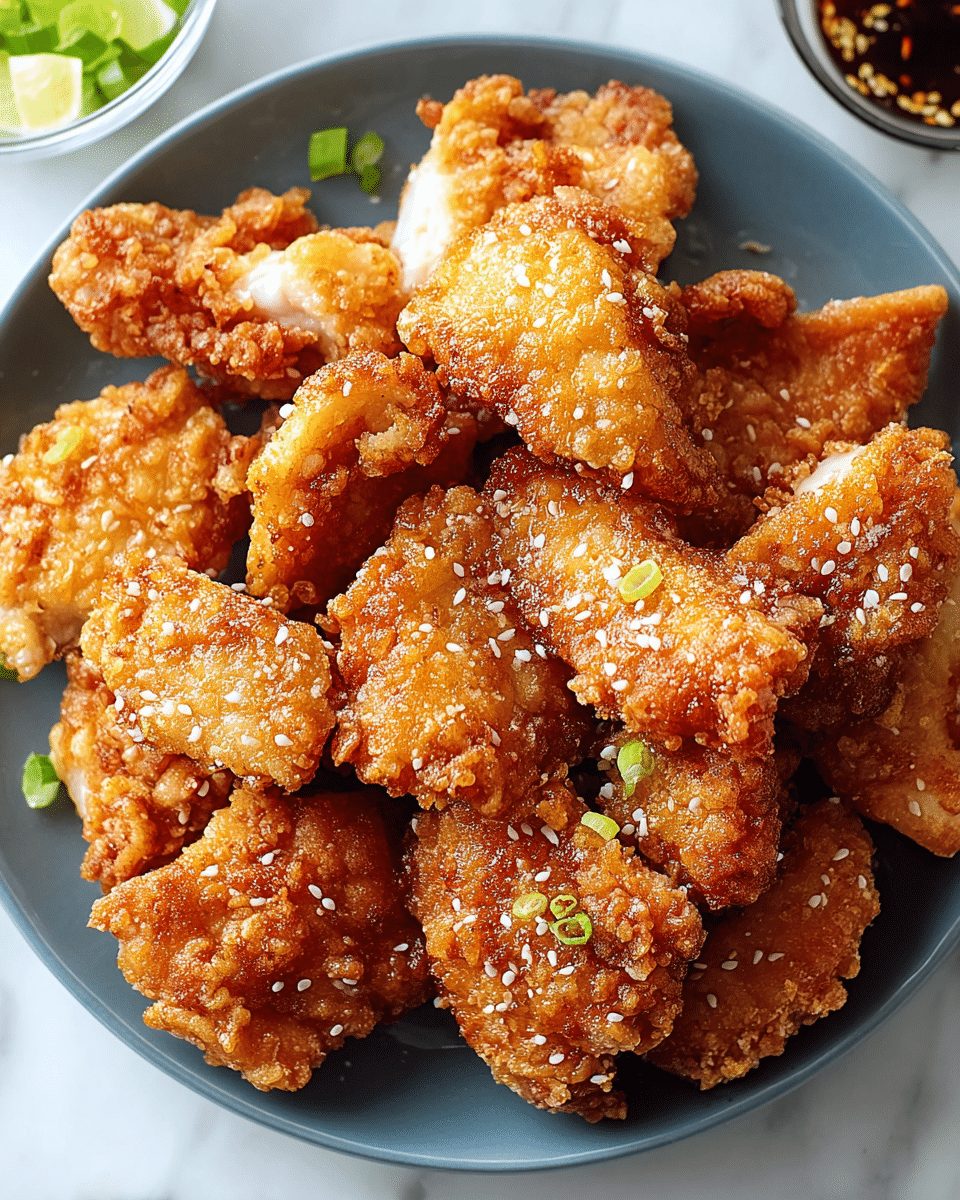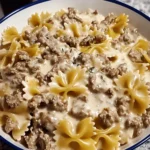The beauty of Japanese Fried Chicken karaage is in its simplicity and flavor. Juicy chicken thighs are marinated, coated in a perfectly balanced batter, and fried to golden crisp perfection. Each bite offers that satisfying crunch, followed by a burst of savory umami flavor, enhanced with hints of garlic and ginger.
Whether served with shredded cabbage, a zesty citrus dip, or just on its own, karaage makes an irresistible appetizer, snack, or main dish. It’s a beloved comfort food across Japan, and now it’s your turn to master it at home. Crispy, flavorful, and ridiculously easy to love this dish is sure to become a favorite at your table.
Full Recipe:
Ingredients:
-
1 pound chicken thighs, boneless and skinless
-
1/2 cup cornstarch
-
1/2 cup all-purpose flour
-
1 teaspoon salt
-
1/2 teaspoon black pepper
-
1/2 teaspoon garlic powder
-
1/2 teaspoon ginger powder
-
1/2 cup cold water
-
1 large egg
-
Vegetable oil for frying
Directions:
-
Cut the chicken thighs into bite-sized pieces, roughly equal in size.
-
Place the chicken into a large mixing bowl.
-
In a separate bowl, combine cornstarch, flour, salt, pepper, garlic powder, and ginger powder.
-
Crack the egg into another bowl, whisk until smooth, then mix in the cold water.
-
Pour the egg-water mixture into the dry ingredients and stir until a thick, smooth batter forms.
-
Add chicken pieces to the batter and coat thoroughly.
-
Heat vegetable oil in a deep pan (2–3 inches deep) over medium-high heat.
-
Test oil by dropping a bit of batter in; it should sizzle and rise.
-
Fry chicken in batches to avoid overcrowding, 4–5 minutes per batch, turning for even crispness.
-
Remove fried chicken with tongs and drain on a paper towel-lined plate.
-
Repeat until all chicken is cooked and crispy.
-
Serve hot and enjoy immediately for best texture.
Prep Time: 15 minutes | Cooking Time: 20 minutes | Total Time: 35 minutes
Kcal: 400 kcal | Servings: 4 servings
The Art of Japanese Fried Chicken (Karaage): A Deep Dive into Japan’s Crispiest Comfort Food
When it comes to comfort food that’s universally loved, fried chicken sits high on the list. And while every culture has its own delicious take on it, Japanese Fried Chicken, known as karaage, offers something uniquely satisfying. It’s crispy without being greasy, flavorful yet light, and somehow manages to feel both indulgent and comforting at once.
Originating in Japan but beloved worldwide, karaage has found a special place in everything from izakaya menus to home-cooked meals and bento boxes. But what makes karaage so irresistible? What sets it apart from American Southern-style fried chicken or Korean yangnyeom varieties? The answer lies in the thoughtful techniques and flavors that define Japanese cuisine.
A Taste of History and Culture
Karaage literally means “Tang-style fried,” hinting at Chinese culinary influence. It gained popularity in Japan during the early 20th century but became more mainstream during the post World War II era as access to cooking oil and meat became more affordable. Originally used to describe a method of frying foods without batter, the term evolved and became synonymous with this specific fried chicken preparation. Today, karaage is enjoyed across Japan and around the globe.
Unlike many Western dishes that prioritize richness, karaage’s beauty lies in its balance deep umami notes from soy-based marinades, brightness from ginger and garlic, and that ethereal crunch from its expertly crafted coating. In Japan, you’ll find karaage not only in homes but also in convenience stores, school lunch boxes, festivals, and izakayas. It’s a cultural staple, almost a rite of passage for home cooks.
What Sets Karaage Apart?
The uniqueness of karaage lies in its preparation technique and seasoning. While many types of fried chicken involve a thick batter or breading, karaage uses a more delicate, lightly dusted coating that results in a thinner, crispier shell. This allows the flavor of the chicken itself usually juicy thigh meat to shine through.
What also makes karaage special is its marinade-first, batter-later approach. Before frying, the chicken is soaked in a mixture often made with soy sauce, sake or mirin, grated ginger, and garlic. This infuses the meat with deep, savory flavors. The chicken is then lightly dredged in a combination of flour and cornstarch before hitting the hot oil.
Another difference? The texture. Karaage has a trademark shattering crunch thanks to its light starch coating and the way it’s fried often in smaller batches to maintain oil temperature. Some chefs even double-fry it to boost crispiness while keeping the interior juicy.
Perfecting Karaage at Home
Though karaage is simple in principle, getting it just right requires some attention to detail:
-
Use the right cut: Chicken thighs are ideal due to their higher fat content, which keeps the meat moist during frying. While breast can be used, it tends to dry out more easily.
-
Marination is key: Even a short 30-minute marinade makes a big difference, but if you have time, letting it rest for a few hours (or even overnight) will deepen the flavor.
-
Control the temperature: Use a thermometer if possible and maintain oil heat around 350°F (175°C). Too hot and the outside will burn before the inside cooks; too cool and the chicken will absorb too much oil.
-
Drain properly: Rest the fried chicken on a wire rack rather than paper towels to prevent the underside from steaming and softening.
How to Serve Karaage: Classic & Creative Ways
Karaage is remarkably versatile and can be served in numerous delicious ways depending on the occasion:
-
With Shredded Cabbage: The classic Japanese pairing. The raw crunch of cabbage complements the rich, fried chicken perfectly. A drizzle of sesame dressing elevates the dish.
-
In Bento Boxes: Karaage is a common inclusion in Japanese lunch boxes, served alongside rice, pickles, tamagoyaki (rolled omelet), and seasonal vegetables.
-
With Lemon Wedges: A simple squeeze of lemon adds brightness and cuts through the oil, refreshing your palate with every bite.
-
With Spicy Mayo or Ponzu Sauce: For a modern twist, dip karaage in a mixture of sriracha and mayonnaise or tangy ponzu for added zest.
-
On a Rice Bowl (Donburi): Layer karaage over steamed rice with pickled veggies and a soft-boiled egg for a comforting and complete meal.
Delicious Variations to Try
One of the joys of karaage is how adaptable it is. Once you’ve mastered the basic version, here are a few creative directions to explore:
-
Yuzu Kosho Karaage: Add a dollop of this spicy, citrusy Japanese condiment to your marinade for a zesty kick.
-
Karaage Tacos: Fuse Japanese and Mexican flavors by serving karaage in small corn tortillas with cabbage slaw and miso-lime crema.
-
Sweet Chili Glaze: After frying, toss the chicken in a glaze made of soy, rice vinegar, sugar, and chili flakes for a sticky-sweet-spicy flavor.
-
Karaage Sliders: Sandwich the chicken in small buns with Japanese mayo and pickled cucumbers for a party-friendly option.
Storing and Reheating Leftovers
Like most fried foods, karaage is best eaten fresh, but with a few tricks, you can preserve its deliciousness:
Short-Term: Let the chicken cool completely, then store in an airtight container in the fridge for up to 2 days. To reheat, avoid the microwave, which makes the coating soggy. Instead, use a skillet with a touch of oil, or better yet, an air fryer or hot oven (around 375°F) to restore crispness.
Freezing: Place cooled karaage pieces on a baking sheet and freeze individually before transferring to a ziplock bag. Reheat directly from frozen in the oven or air fryer until hot and crispy.
Pro tip: Reheated karaage makes a delicious filling for sandwiches, wraps, or even ramen toppings.
Why Karaage is a Must-Try for Any Home Cook
Karaage checks all the boxes for what we love in comfort food crispy, juicy, flavorful, and adaptable. It’s approachable even for beginner cooks and opens the door to exploring Japanese flavors without complex ingredients or equipment. Plus, it’s an instant crowd-pleaser, whether you’re serving it at a family dinner, a picnic, or a game day spread.
More than just a recipe, karaage is an experience. The sizzling sound as the chicken fries, the tantalizing aroma of garlic and soy wafting through your kitchen, and that first bite hot, crunchy, and full of umami make it a sensory delight.
Conclusion:
At its heart, karaage is a humble dish with wide appeal. It represents the essence of Japanese home cooking simple ingredients elevated through care, balance, and technique. Once you’ve tried it, it’s easy to see why it has such a devoted following.
Whether you serve it with rice and lemon for a quick weeknight meal or dress it up with gourmet sauces for a weekend feast, Japanese fried chicken is one of those dishes that always hits the mark. It’s a love letter to crispiness, a testament to umami, and an invitation to play in the kitchen.






